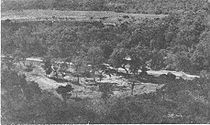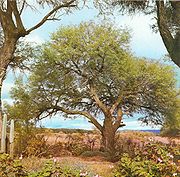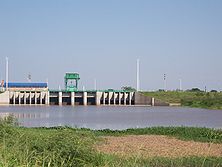Gran Chaco

The Gran Chaco (Quechua chaqu, "hunting land"), dubbed by some as "the last South American frontier", is a sparsely populated, hot and semi-arid lowland region of the Río de la Plata basin, divided between eastern Bolivia, Paraguay, northern Argentina and a portion of the Brazilian state of Mato Grosso.
Contents |
Geography


| Regions of |
|---|
| Argentine Northwest |
| Gran Chaco |
| Mesopotamia |
| Cuyo |
| Pampas |
| Patagonia |
| Antártida Argentina |
The Gran Chaco is about 647,500 km2 (250,001 sq mi) in size, though estimates differ. It is located west of the Paraguay River and east of the Andes, mostly on a plateau shared between Paraguay, Bolivia and Argentina. It stretches from about 17° to 33° South latitude and between 65° and 60° West longitude, though estimates differ in this case too. Closer to the mountains in the west, the Alto Chaco, or Dry Chaco, is very dry and sparsely vegetated, but continuing eastward to the Bajo Chaco, or Humid Chaco, one encounters lots of thornbrush jungle with quebracho trees and grassy clearings with a wealth of insects. The landscape is mostly flat and slopes at a 0.004 degree gradient to the east. This area is also one of the distinct physiographic provinces of the Parana-Paraguay Plain division.
The area is hospitable to development only along the Paraguay, Bermejo and Pilcomayo Rivers. It is a great source of timber and tannin, which is derived from the native quebracho tree. Special tannin factories have been constructed there. The wood of the palo santo from the Central Chaco, is the source of oil of guaiac (a fragrance for soap). Paraguay also cultivated mate in the lower part of Chaco.
History
Gran Chaco was a disputed territory since 1810. Officially, it was supposed to be part of Argentina, Bolivia and Paraguay, although a bigger land portion west of the Paraguay River had corresponded to Paraguay since its independence. Argentina claimed territories south of the Bermejo River until Paraguay's defeat in the War of the Triple Alliance in 1871 established its current border with Argentina. Over the next few decades, Bolivia began to push the natives out and settle in the Gran Chaco while Paraguay ignored it. It was the scene of The Gran Chaco War (1932-1935) (though violence started as early as December 5, 1928) between Paraguay and Bolivia over supposed oil in Chaco Boreal (a region north of the Pilcomayo River and to the west of the Paraguay River). Bolivia sought the Paraguay River for shipping oil out into the sea (it had become a land-locked country after the loss of its Pacific coast in the War of the Pacific) and Paraguay claimed ownership of the land. Eventually, Argentine Foreign Minister Carlos Saavedra Lamas mediated a treaty signed in 1938, which gave Paraguay three quarters of Chaco Boreal and gave Bolivia a corridor to the Paraguay River with the ability to use the Puerte Cosado and the right to construct their own port. In the end, oil was not found there.
Mennonites came into the Paraguayan part of the region from Canada in the 1920s; more came from the USSR in the 1930s and immediately following World War II. These immigrants created some of the largest and most prosperous municipalities in the deep Gran Chaco.
The region is home to around ten million people, divided about evenly between Argentina, Bolivia, Brazil and Paraguay. The area remains relatively underdeveloped, however; to help address this, in the 1960s the Paraguayan authorities had the Trans-Chaco Highway built and the Argentine National Highway Directorate, Route 16 and Route 81. All three highways extend about 700 km (450 mi) from east to west and are now completely paved, as are a network of nine Brazilian highways in Mato Grosso do Sul State.
Flora and fauna

The Gran Chaco has some of the highest temperatures on the continent
The ecosystems of the Gran Chaco are unique, and were little understood by scientists until recent years. These ecosystems are slowly being destroyed by civilization with the introduction of cattle, burning of vegetation and irresponsible agricultural decisions. Many groups are trying to protect this unique set of ecosystems.
The Chacoan Peccary (Catagonus wagneri), which was discovered in the 1970’s, is a large mammal endemic to Chaco. Chaco is a center of Armadillo diversity, with at least eight species in the Argentine Chaco and ten species in the Paraguayan Chaco.
In September 1995, the Kaa Iya del Gran Chaco National Park was established in an area of Chaco in Bolivia. It is administered and was established solely by the indigenous peoples which include the Izoceño Guaraní, the Ayoreode, and the Chiquitano.
Chaco and fuel crops
Chaco is one of South America’s last agricultural frontiers. Very sparsely populated and lacking sufficient all weather roads and basic infrastructure (the Argentinian part is more developed then the Paraguayan or Bolivian part), it has long been too remote for crop planting. The central Chaco’s Mennonite Colonies are a notable exception.
Two aspects may substantially change Chaco in the near future. Low land valuations [1] [2] and the the region's suitability to grow fuel crops. Suitability for the cultivation of Jatropha has been proven [3] [4], Sweet sorghum as ethanol plant may prove viable, too, since sorghum for domestic and feedstock use is a traditional local crop. Switchgrass / Pasto Varilla’s feasability is currently studied by Argentina’s INTA [5], so is the Karanda’y palmtree in the Paraguay Chaco [6].
While the advance of agriculture will bring some improvements on infrastructure and employment for this traditionally rather neglected and impoverished region, loss of habitat / virgin forest could be substantial.
Administrative divisions in the Gran Chaco




The following Argentine provinces, Bolivian and Paraguayan departments and Brazilian states lie in the Gran Chaco area entirely, or in part:
- Alto Paraguay Department, Paraguay
- Beni Department, Bolivia
- Boquerón Department, Paraguay
- Chaco Province, Argentina
- Chuquisaca Department, Bolivia
- Formosa Province, Argentina
- Mato Grosso do Sul State, Brazil
- Presidente Hayes Department, Paraguay
- Salta Province, Argentina
- Santa Cruz Department, Bolivia
- Santa Fe Province, Argentina
- Santiago del Estero Province, Argentina
- Tarija Department, Bolivia
- Tucumán Province, Argentina
Indigenous peoples of the Gran Chaco
- Abipón - no longer exist
- Ayoreo
- Chamacoco
- Chané
- Chiquitano
- Chiripá
- Chorote
- Enxet
- Enlhet
- Guana
- Ava Guaraní
- Simba Guaraní
- Guarayo
- Kaiwá
- Maká
- Maskoy
- Mbyá
- Mocoví
- Nivaclé
- Pai Tavytera
- Pilagá
- Pucú
- Sanapaná
- Tapieté
- Toba
- Wichí
- Yuqui
References
- ↑ "Impenetrable olvido (..tan bajo el valor de la tierra que con dos campañas, sobra..)" (in Spanish), AMBIENTE-ARGENTINA. Retrieved on 2008-09-09.
- ↑ "Cada vez más Uruguayos compran campos Guaranés" (in Spanish), Consejo de Educacion Secundaria de Uruguay (26 June 2008).
- ↑ "Jatropha en el Chaco" (in Spanish), Diario ABC Digital. Retrieved on 2008-09-09.
- ↑ "Jatropha Chaco" (in Spanish), Incorporación del cultivo Jatropha Curcas L en zonas marginales de la provincia de chaco. Retrieved on 2008-09-09.
- ↑ "Aprovechamiento de recursos vegetales y animales para la produccion de biocombustibles" (in Spanish), INTA (26 June 2008).
- ↑ "Varias iniciativas están en marcha con vistas a la producción de biodiesel" (in Spanish), RIEDEX / Ministerio de Industria y Comercio (de Paraguay). Retrieved on 2008-09-09.
External links
- The National Museum of Natural History's description of Gran Chaco
- Chaco ecoregion (World Wildlife Fund)
- Humid Chaco ecoregion (World Wildlife Fund)
- Food and Agriculture Organization of the United Nations' description of the Gran Chaco - focuses mainly on agriculture.
- Some stamps showing the dispute over the Gran Chaco before the war - some people claim this was the spark that ignited the war
- photos of the Paraguay Chaco
|
||||||||||||||||||||||
|
|||||||
